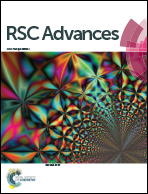Immunomodulatory and antimicrobial non-mulberry Antheraea mylitta silk fibroin accelerates in vitro fibroblast repair and regeneration by protecting oxidative stress†
Abstract
The antimicrobial nature of Antharaea mylitta silk-fibroin (SF) is reported but antioxidant potential and the immunomodulatory role towards the fibroblast cell repair process is not explored. Polyurethane is reported to have inflammatory potential by mononuclear cells directed cytokine release, which can guide fibroblast repair. Present study demonstrates the conjunctive effect of inflammatory PU/SF to regulate the favorable shift from pro-inflammatory to anti-inflammatory cytokine stimulation for accelerated fibroblast repair. Minimal inhibitory concentration of SF was determined against pathogenic strains and the effect of SF was investigated for fibroblast NIH3T3 cell adhesion. SF doses (8, 8.5, 9 mg mL−1) were found to be greater than both the IC50 of DPPH scavenging and the ED50 for NIH3T3 proliferation. Anti-lipid peroxidase (ALP) activity of SF doses and citric acid-treated NIH3T3 cells were compared under hydrogen peroxide (H2O2) induced oxidative stress. 9 mg mL−1 SF showed greater ALP activity than the citric acid standard. SF-driven protection to oxidative damage was measured by viable cell fraction in trypan blue dye exclusion assay where 9 mg mL−1 SF showed the highest viability (p ≤ 0.05). 9 mg mL−1 SF was blended with PU for scaffold (w/v = 2 : 5, 2 : 7, 2 : 9) fabrication. The protective effect of PU/SF (2 : 5, 2 : 7, 2 : 9) against oxidative stress was verified by damaged cell survival in MTT assay and DNA quantification. The highest number of cells survived on PU/SF (2 : 9) at all intervals (p ≤ 0.01) upon oxidative damage; PU/SF (2 : 9) was also fabricated by employing the immobilization technique. Immobilized PU/SF (2 : 9) exhibited a greater zone of microbial inhibition, a higher extent of inhibition to microbial adherence, and caused more LDH release from bacterial cell membrane due to membrane rupture, resulting in bacterial cell death (E. coli, K. pneumoniae, P. aeruginosa, S. aureus) compared to the experimental results shown by blended PU/SF (2 : 9). The protective nature of PU/SF (2 : 9) against oxidative stress was ensured through the LDH activity of damaged NIH3T3 cells. Initial raised IL-6, TNF-alpha (pro-inflammatory cytokines) and lowered IL-8, IL-10 (anti-inflammatory cytokine) profiles coupled with fallen IL-6, TNF-alpha, and elevated IL-8, IL-10 at later hours synergistically progress the inflammatory phase of in vitro scratch wound repair in mononuclear culture treated by PU/SF (2 : 9).



 Please wait while we load your content...
Please wait while we load your content...